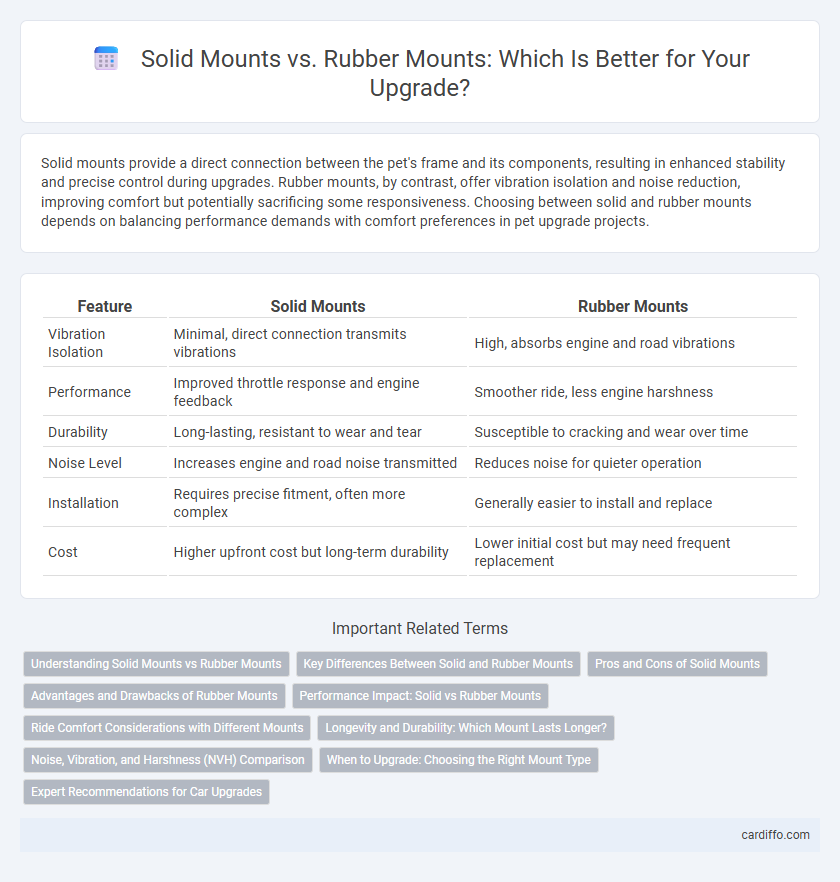Solid mounts provide a direct connection between the pet's frame and its components, resulting in enhanced stability and precise control during upgrades. Rubber mounts, by contrast, offer vibration isolation and noise reduction, improving comfort but potentially sacrificing some responsiveness. Choosing between solid and rubber mounts depends on balancing performance demands with comfort preferences in pet upgrade projects.
Table of Comparison
| Feature | Solid Mounts | Rubber Mounts |
|---|---|---|
| Vibration Isolation | Minimal, direct connection transmits vibrations | High, absorbs engine and road vibrations |
| Performance | Improved throttle response and engine feedback | Smoother ride, less engine harshness |
| Durability | Long-lasting, resistant to wear and tear | Susceptible to cracking and wear over time |
| Noise Level | Increases engine and road noise transmitted | Reduces noise for quieter operation |
| Installation | Requires precise fitment, often more complex | Generally easier to install and replace |
| Cost | Higher upfront cost but long-term durability | Lower initial cost but may need frequent replacement |
Understanding Solid Mounts vs Rubber Mounts
Solid mounts provide a direct connection between components, minimizing flex and maximizing engine response and power transfer, ideal for performance upgrades where precision is key. Rubber mounts incorporate flexible rubber layers that absorb vibrations and noise, enhancing ride comfort and reducing harshness, making them suitable for daily driving and long-distance comfort. Understanding the trade-offs between solid and rubber mounts helps optimize vehicle performance and comfort based on driving needs and upgrade goals.
Key Differences Between Solid and Rubber Mounts
Solid mounts provide direct engine-to-chassis connection, significantly reducing engine movement and improving acceleration response, making them ideal for performance upgrades. Rubber mounts incorporate elastomeric materials that absorb vibration and noise, enhancing ride comfort and reducing cabin harshness in daily driving conditions. The key difference lies in balancing rigidity versus damping: solid mounts prioritize stiffness and control, while rubber mounts emphasize vibration isolation and noise reduction.
Pros and Cons of Solid Mounts
Solid mounts provide superior engine stability and precise power transfer by minimizing movement, enhancing vehicle performance and responsiveness. However, they transmit more engine vibration and noise to the chassis, potentially reducing driving comfort and increasing cabin harshness. Despite this, solid mounts offer durability and improved handling, making them ideal for performance-focused upgrades.
Advantages and Drawbacks of Rubber Mounts
Rubber mounts excel in vibration dampening and noise reduction, making them ideal for engines and machinery where minimizing resonance is crucial. Their flexibility allows for slight movement, reducing stress on components and extending durability, but this elasticity can lead to less precise alignment compared to solid mounts. Over time, rubber mounts may degrade due to heat, oil exposure, and wear, requiring more frequent replacement to maintain optimal performance.
Performance Impact: Solid vs Rubber Mounts
Solid mounts provide superior engine stability by minimizing movement and enhancing throttle response, which results in improved performance and sharper handling. Rubber mounts absorb vibrations and reduce noise but allow more engine movement, leading to less precise power delivery and a softer driving feel. Choosing solid mounts enhances performance by delivering more direct engine-to-chassis connection, optimizing power transfer and responsiveness on high-performance vehicles.
Ride Comfort Considerations with Different Mounts
Solid mounts provide a direct connection between the engine and chassis, resulting in minimal vibration absorption but increased road noise and harsher ride quality. Rubber mounts incorporate flexible materials that effectively dampen vibrations, enhancing ride comfort by reducing engine and road impact transferred to the cabin. Choosing between solid and rubber mounts balances engine stability with passenger comfort, depending on vehicle use and performance priorities.
Longevity and Durability: Which Mount Lasts Longer?
Solid mounts offer superior longevity and durability due to their rigid construction, which resists wear and deformation over time, making them ideal for high-performance and heavy-duty applications. Rubber mounts, while providing better vibration dampening, tend to degrade faster from exposure to heat, oil, and environmental elements, resulting in shorter lifespan and more frequent replacements. For long-term durability, solid mounts outperform rubber mounts by maintaining structural integrity under extreme conditions.
Noise, Vibration, and Harshness (NVH) Comparison
Solid mounts provide superior engine stability and reduced powertrain movement but tend to increase Noise, Vibration, and Harshness (NVH) due to their rigidity. Rubber mounts absorb vibrations effectively, significantly lowering NVH levels for a smoother, quieter ride but may allow slight engine movement. For performance upgrades, solid mounts enhance responsiveness at the cost of increased NVH, while rubber mounts prioritize comfort with reduced noise and vibration.
When to Upgrade: Choosing the Right Mount Type
Upgrading to solid mounts improves engine stability and throttle response by reducing movement, making them ideal for performance enthusiasts and track use. Rubber mounts excel in vibration damping and noise reduction, providing comfort suited for daily driving and long-distance cruising. Select solid mounts for enhanced handling and precision, while rubber mounts remain optimal for maintaining ride comfort during everyday use.
Expert Recommendations for Car Upgrades
Expert recommendations for car upgrades emphasize that solid mounts deliver superior engine stability and improved throttle response, making them ideal for performance-focused vehicles. Rubber mounts, however, provide better vibration damping and ride comfort, suited for daily driving and long-distance travel. Selecting between solid and rubber mounts depends on prioritizing either performance enhancement or ride quality based on the intended driving conditions.
Solid Mounts vs Rubber Mounts Infographic

 cardiffo.com
cardiffo.com